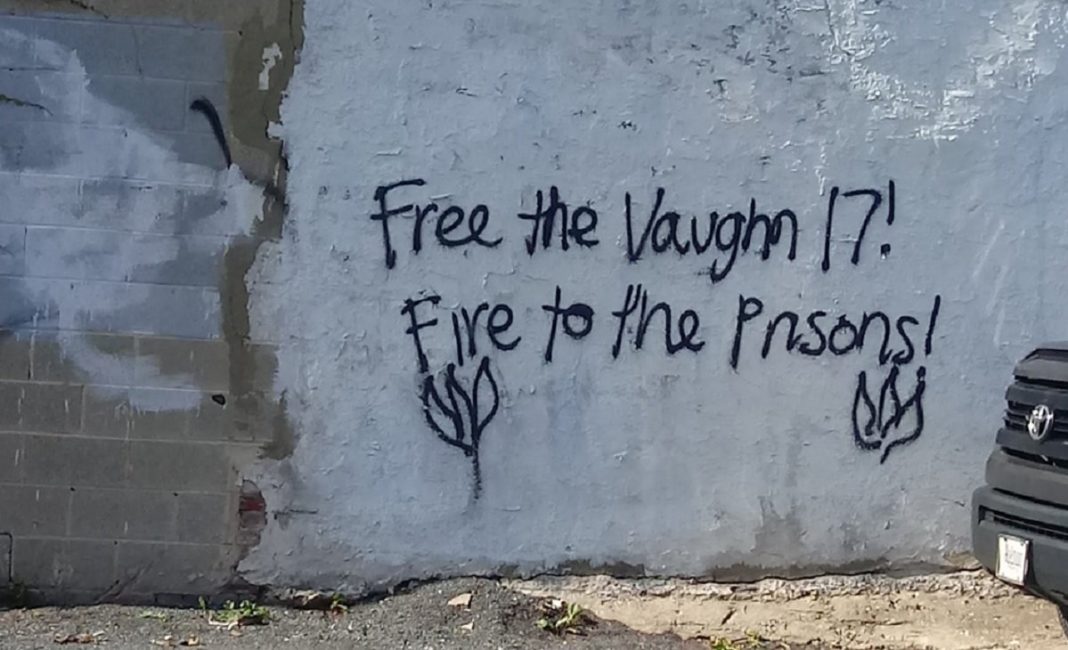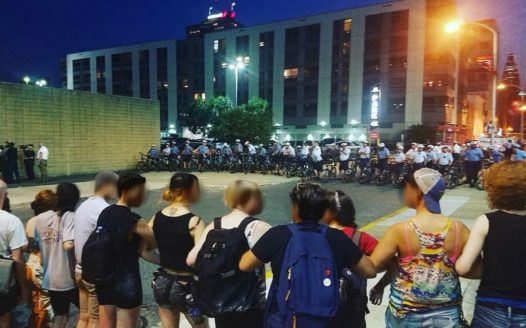from Support the Vaughn 17
The fourth week of this incredibly long and punitive trial saw defendants Abednego Baynes, Kevin Berry, John Bramble, and Obadiah Miller finally able to speak to the lies the state’s used to construct a case against them. Two defendants from the first trial — Jarreau Ayers and Dwayne Staats — also testified this week, revealing new information about the parts they played regarding the takeover. Other inmate defense witnesses completely discredited the testimony of several of the state’s witnesses, leaving the state with even less of a case against any of the remaining defendants.
Monday, February 4th, saw the tail end of the prosecution’s case. After two weeks of unreliable testimony from unlikeable inmate witnesses, on Friday the state had finally managed to produce a somewhat competent witness, Michael “Latino” Rodriguez. Rodriguez testified that he saw Bramble assault Officer Wilkinson and that he saw Miller stab Sergeant Floyd. Monday’s cross-examination showed that Rodriguez’s testimony contradicted that of other inmates, that he’d gotten information about what’d happened from other people, and that his motivation for cooperating was to get out of jail rather than having been moved by his “conscience.” But he seemed to have made a better impression on the jury than previous witnesses. After lead investigator David Weaver testified about the investigation again, the prosecution rested on Monday.
“I shouldn’t be here.” – Kevin Berry
Kevin Berry’s defense began by calling a few fellow prisoners who were with him during the takeover and attested to his lack of involvement. One prisoner, Joseph Galloway, discredited state witness Henry Anderson’s testimony, saying he was asleep during the assaults he’d said he saw: “Unless he’s superman, he didn’t see nothing cuz he never left the room.” When questioned, he also said that no one had been down near the hot pot watching the assaults, which wipes out another state witness’ testimony. Berry then testified, noting the “bullshit stories” of the prosecution’s witnesses and explaining to the jury that he should never have been charged.
“Peaceful protests don’t work. I’m past that.” – Dwayne Staats
Obadiah Miller’s defense counsel brought up Jarreau Ayers, who admitted he’d lied during the previous trial and that he had in fact collaborated with his co-defendant Dwayne Staats to plan the takeover. Ayers explained he’d made the decision to risk perjury and attest to this now because he’d come to realize that the uprising was a “righteous cause” and that he needed to accept responsibility for it. He said he couldn’t bear to see men who had nothing to do with the takeover being convicted for things he’d decided to do, even though it meant that he now stands no chance of ever leaving prison. Ayers told the courtroom, “I’m sacrificing everything to be here today.”
Staats also expanded on his role in the takeover. During his and Ayers’ trial in the fall, Staats had explained (not under oath, according to him) that he had sought to plan the takeover along with other “lifers” — people who had nothing to lose — and had recruited six other prisoners to take part. On Wednesday of this past week, Staats told the court that he’d also been the first to punch Sergeant Floyd, a signal that attacks on all the officers were to begin. This new admission made the prosecution furious. Staats shrugged this off, explaining that his defense had been based on what the investigators said about him, and that they hadn’t been able to find a witness who said they’d seen him hit anyone.
Ayers and Staats both convincingly explained why they had not recruited the particular defendants on trial to take part in the prison takeover. Of Bramble, Ayers said “Can I be honest? He and his friends just get high all the time.” When asked if any white guys had been asked to participate in the uprising, Ayers laughed and said, “No.”
Staats explained that he’d seen firsthand that Kevin Berry didn’t have the potential to be part of the takeover when an officer had put hands on Berry previously and he did nothing in response. Neither of them knew Baynes, who kept to himself. Miller was known as a tier man, who, as Staats explained, were handpicked and trusted by the police, meaning they were not trusted by other inmates. Miller also testified to this in his own defense, explaining to the jury that many of the inmates who’d lied about his involvement in the uprising had problems with him because he’d been picked for the job despite others having seniority over him.
Baynes testified on Wednesday that he’d spent the morning of the takeover watching Rachel Ray, which he watched every day, and that he’d left before it was over. When questioned about masked inmates he’d seen at a distance during the uprising, he replied, “If you want me to guess, I can play a guessing game like your witnesses did.”
After much censorship and condescension from Judge Carpenter, Baynes’ defense attorney Cleon Cauley was finally allowed to bring up prison expert and correctional operations consultant James Aiken. Aiken testified that inmates should be housed separately after a “critical incident” in order to minimize “contamination” of the investigation. In this case, they were housed together; some people who are now state witnesses were even in the same cells. The judge did not allow him to testify about several significant matters.
John Bramble’s defense presented one prisoner who’d been cellmates with Melvin Williams, who had testified previously that Bramble had come to his cell saying he’d attacked Floyd. Williams’ cellmate testified that no one had ever come to his cell that day saying that. Another inmate’s testimony discredited testimony from another state witness, Larry Sartin. The most significant testimony that day, though, came from prisoner Terek Downing, who had taken care of Counselor May in his cell during the uprising and had witnessed the attack on Sergeant Floyd. Downing exonerated Bramble, whom he’d seen also watching the attack. Downing also completely undermined the previous testimony of state witness Carello, who he said stayed in his cell during the attacks he said he’d seen, and described state witness Rodriguez’s claim that he had also been with Ms. May as “completely false.” Like several defense witnesses before him, Downing described the case against the current defendants as “frustrating” and told the court, “Y’all got the wrong people on trial.”
Bramble’s testimony closed out the defense. Bramble spoke out against state witness Michael Carello’s (now-discredited) claim that Bramble had bragged that he’d “gutted Floyd like a whale, and felt like a KKK member while doing it.” Bramble responded: “That doesn’t even make sense. My mom is black and my little sister and brother are half-black. I was ashamed when he said that. That’s offensive.”
Bramble also spoke to the brutality endured by C-building’s inmates right after the takeover, which he described as a “full-on assault.” Lieutenant Vanes, who’d commanded the force that eventually blitzed the building, had testified that they had used force because prisoners were resisting. Bramble testified that no one had resisted.
Four to five days after the takeover, the 18 prisoners who were ultimately indicted were chosen to be moved to a different building. For a week, Bramble testified, they had only the clothes they’d had on, which were still wet, and no shoes. They weren’t allowed to take showers or make phone calls for five days. When transferred to a different prison, they were put on a tier with nothing, their property was confiscated again, they weren’t given property or books for three months, and they had to go on a hunger strike in order to get their allotted recreation time.
The prosecution succeeded in getting some moderate convictions in the first Vaughn 17 trial because two of the defendants, Ayers and Staats, offered up testimony regarding their involvement in the takeover. The third defendant, Deric Forney, whom only a few witnesses claimed to have seen assaulting an officer, maintained his innocence and was acquitted on all charges.
This trial is different. This time, all four defendants are in Deric Forney’s position. A few more state witnesses have “evolved” their stories to include Bramble and Miller’s names, and there is a questionable DNA sample related to Miller, who as a tier man had regular access to where it was found. But Bramble, Miller, Berry and Baynes have all held out under pressure and abuse for the past two years to stay in solidarity with their co-defendants. They have now convincingly attested to their lack of involvement in the takeover and some of the ways in which they were targeted as part of the state’s desperate attempt at retaliation for one of the most important uprisings so far this century.
The prosecution and the defense’s closing arguments will take place on Monday, February 11, starting at 9:00am in Room 8B at the New Castle County Courthouse in Wilmington, Delaware. Jury deliberations are expected to begin on Tuesday morning.


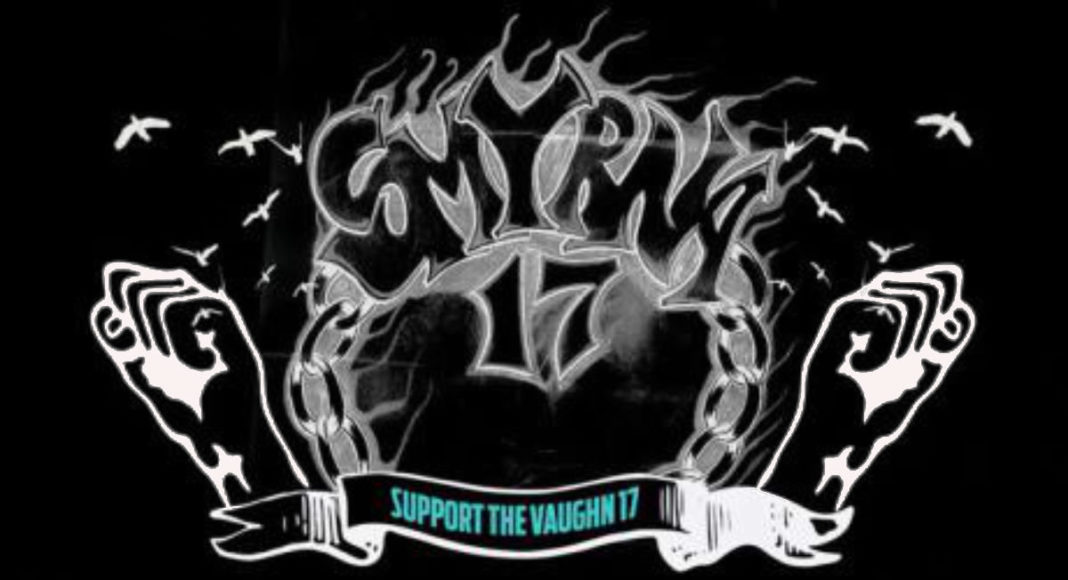
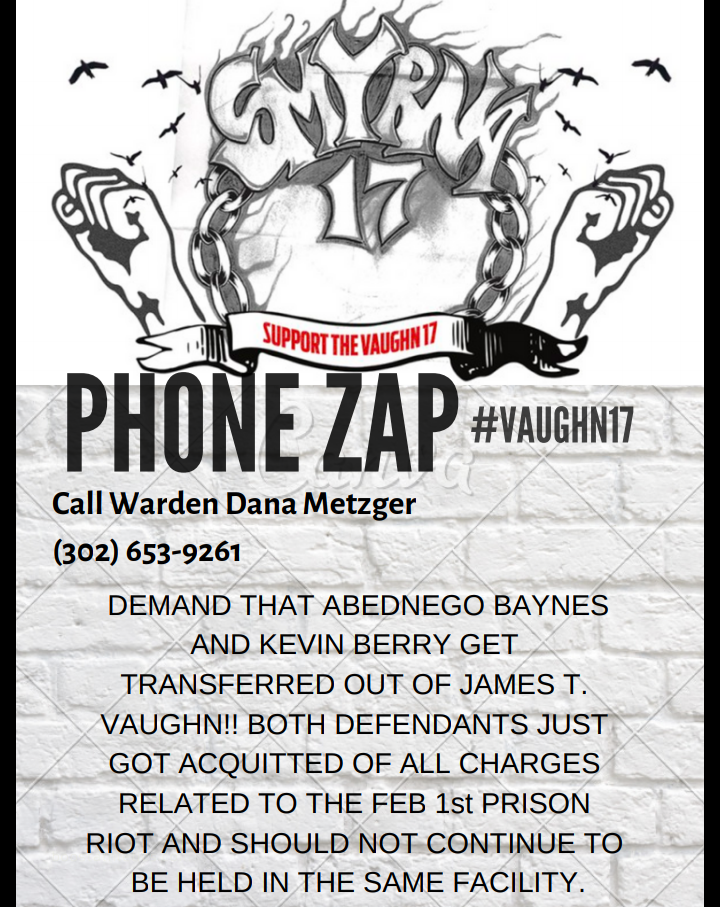
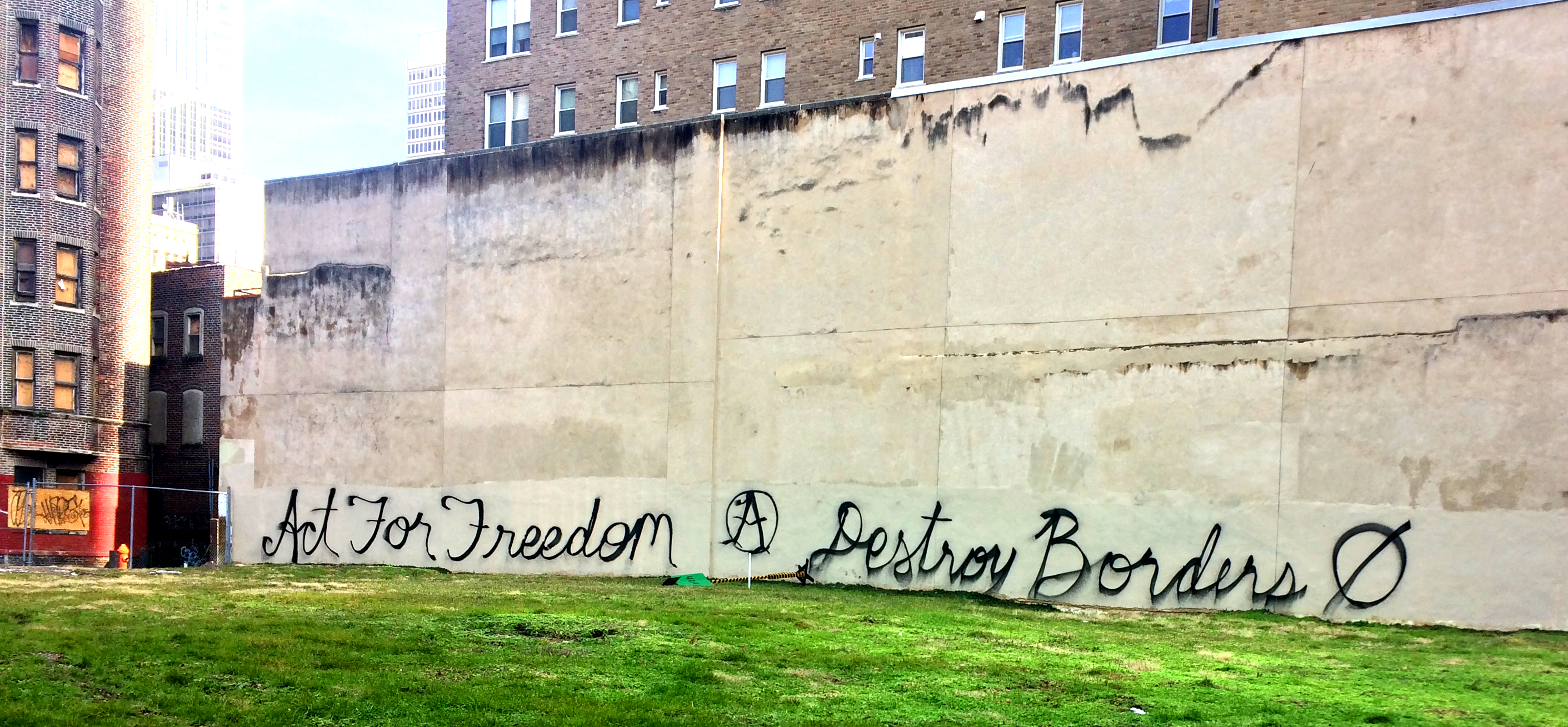

 Where: A-Space, 4722 Baltimore Avenue
Where: A-Space, 4722 Baltimore Avenue